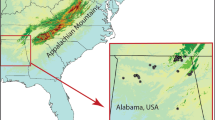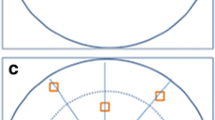Abstract
The variability of biological data is a main constraint affecting the quality and reliability of lichen biomonitoring surveys for estimation of the effects of atmospheric pollution. Although most epiphytic lichen bioindication surveys focus on between-site differences at the landscape level, associated with the large scale effects of atmospheric pollution, current protocols are based on multilevel sampling, thus adding further sources of variation and affecting the error budget. We test the hypothesis that assemblages of lichen communities vary at each spatial scale examined, in order to determine what scales should be included in future monitoring studies. We compared four sites in Italy, along gradients of atmospheric pollution and climate, to test the partitioning of the variance components of lichen diversity across spatial scales (from trunks to landscapes). Despite environmental heterogeneity, we observed comparable spatial variance. However, residuals often overcame between-plot variability, leading to biased estimation of atmospheric pollution effects.




Similar content being viewed by others
References
Anderson, M. J. (2001a). A new method for non-parametric multivariate analysis of variance. Austral Ecology, 26, 32–46.
Anderson, M. J. (2001b). Permutation tests for univariate or multivariate analysis of variance and regression. Canadian Journal of Fisheries and Aquatic Sciences, 58, 626–639.
Anderson, M. J., & ter Braak, C. J. F. (2003). Permutation tests for multi-factorial analysis of variance. Journal of Statistical Computation and Simulation, 73, 85–113.
ANPA. (2001). I.B.L.: Indice di Biodiversità Lichenica. Serie Manuali e Linee Guida, 2/2001. Roma: ANPA.
Asta, J., Erhardt, W., Ferretti, M., Fornasier, F., Kirschbaum, U., Nimis, P. L., et al. (2002). Mapping lichen diversity as an indicator of environmental quality. In P. L. Nimis, C. Scheidegger, & P. Wolseley (Eds.), Monitoring with lichens—monitoring lichens (pp. 273–279). Dordrecht: Kluwer.
Balata, D., Bertocci, I., Piazzi, L., & Nesti, U. (2008). Comparison between epiphyte assemblages of leaves and rhizomes of the seagrass Posidonia oceanica subjected to different levels of anthropogenic eutrophication. Estuarine, Coastal and Shelf Science, 79, 533–540.
Balestri, E., Cinelli, F. & Lardicci, C. (2003). Spatial variation in Poseidonia oceanica structural, morphological and dynamic features in a northwestern Mediterranean coastal area: a multi-scale analysis. Marine Ecology Progress Series, 250, 51–60.
Botkin, D. B. (1990). Discordant harmonies: a new ecology for the twenty-first century. Oxford: Oxford University Press.
Branquinho, C., Gaio-Oliveira, G., Augusto, S., Pinho, P., Maguas, C., & Correia, O. (2008). Biomonitoring spatial and temporal impact of atmospheric dust from a cement industry. Environmental Pollution, 151, 292–299.
Brunialti, G., & Giordani, P. (2003). Variability of lichen diversity in a climatically heterogeneous area (Liguria, NW Italy). The Lichenologist, 35, 55–69.
Brunialti, G., Frati, L., Incerti, G., Rizzi, G., Vinci, M., & Giordani, P. (2009). Lichen biomonitoring of air pollution: issues for applications in complex environments. In G. C. Romano & A. G. Conti (Eds.), Air quality in the 21st century (pp. 211–259). Hauppauge: Nova.
Cao, Y., Bark, A. W., & Williams, P. (1997). A comparison of clustering methods for river benthic community analysis. Hydrobiologia, 347, 25–40.
Cristofolini, F., Giordani, P., Gottardini, E., & Modenesi, P. (2008). The response of epiphytic lichens to air pollution and subsets of ecological predictors: a case study from the Italian Prealps. Environmental Pollution, 151, 308–317.
Davies, L., Bates, J. W., Bell, J. N. B., James, P. W., & Purvis, O. W. (2007). Diversity and sensitivity of epiphytes to oxides of nitrogen in London. Environmental Pollution, 146, 299–310.
Dungan, J. L., Perry, J. N., Dale, M. R. T., Legendre, P., Citron-Pousty, S., Fortin, M. J., et al. (2002). A balanced view of scale in spatial statistical analysis. Ecography, 25, 626–640.
Ellis, C. J. (2011). Lichen epiphyte diversity: a species, community and trait-based review. Perspectives in Plant Ecology, Evolution and Systematics. doi:10.1016/j.ppees.2011.10.001
Ferretti, M., & Erhardt, W. (2002). Key issues in designing biomonitoring programs. Monitoring scenarios, sampling strategies and quality assurance. In P. L. Nimis, C. Scheidegger, & P. Wolseley (Eds.), Monitoring with lichens—monitoring lichens (pp. 111–139). London: Kluwer.
Ferretti, M., Brambilla, E., Brunialti, G., Fornasier, F., Mazzali, C., Giordani, P., et al. (2004). Reliability of different sampling densities for estimating and mapping lichen diversity in biomonitoring studies. Environmental Pollution, 127, 249–256.
Frati, L., & Brunialti, G. (2006). Long-term biomonitoring with lichens: comparing data from different sampling procedures. Environmental Monitoring and Assessment, 119, 391–404.
Frati, L., Santoni, S., Nicolardi, V., Gaggi, C., Brunialti, G., Guttova, A., et al. (2007). Lichen biomonitoring of ammonia emission and nitrogen deposition around a pig stockfarm. Environmental Pollution, 146, 311–316.
Gaston, K. J. (2000). Global patterns in biodiversity. Nature, 405, 220–227.
Geiser, L. H., & Neitlich, P. N. (2007). Pollution and climate gradients in western Oregon and Washington indicated by epiphytic macrolichens. Environmental Pollution, 145, 203–218.
Giordani, P. (2006). Variables influencing the distribution of epiphytic lichens in heterogeneous areas: a case study for Liguria, NW Italy. Journal of Vegetation Science, 17, 195–206.
Giordani, P. (2012). Assessing the effects of forest management on epiphytic lichens in coppiced forests using different indicators. Plant Biosystems. doi:10.1080/11263504.2011.654136
Giordani, P., Brunialti, G., & Alleteo, D. (2002). Effects of atmospheric pollution on lichen biodiversity (LB) in a Mediterranean region (Liguria, northwest Italy). Environmental Pollution, 118, 53–64.
Giordani, P., Calatayud, V., Stofer, S., Granke, O. (2011). Epiphytic lichen diversity in relation to atmospheric deposition. In Fischer R, Lorenz M (eds.). 2011: forest condition in Europe, 2011 Technical Report of ICP Forests and FutMon. Work Report of the Institute for World Forestry 2011/1. ICP Forests, Hamburg, 2011, 212 pp
Gunnar, J. B., & Moen, J. (1998). Patterns in species associations in plant communities: the importance of scale. Journal of Vegetation Science, 9, 327–332.
ISPRA (2008). BRACE. Dati e Metadati di Qualità dell’aria. ISPRA
Jovan, S., & McCune, B. (2005). Air-quality bioindication in the greater central valley of California, with epiphytic macrolichen communities. Ecological Applications, 15, 1712–1726.
Jovan, S., & McCune, B. (2006). Using epiphytic macrolichen communities for biomonitoring ammonia in forests of the greater Sierra Nevada, California. Water, Air, and Soil Pollution, 170, 69–93.
Levin, S. A. (1992). The problem of pattern and scale in ecology. Ecology, 73, 1943–1967.
McArdle, B. H., & Anderson, M. J. (2001). Fitting multivariate models to semi-metric distances: a comment on distance-based redundancy analysis. Ecology, 82, 290–297.
Nascimbene, J., Nimis, P. L., & Marini, L. (2007). Testing indicators of epiphytic lichen diversity: a case study in N Italy. Biodiversity and Conservation, 16, 3377–3386.
Nascimbene, J., Marini, L., Bacaro, G., & Nimis, P. L. (2010). Effect of reduction in sampling effort for monitoring epiphytic lichen diversity in forests. Community Ecology, 11, 250–256.
Nimis, P. L. & Martellos, S. (2008). ITALIC—the information system on Italian Lichens. Version 4.0.
Nimis, P. L., Scheidegger, C., & Wolseley, P. A. (2002). Monitoring with lichens—monitoring lichens. Dordrecht: Kluwer. Published in association with the NATO Scientific Affairs Division.
Palmer, M. W. (1990). Spatial scale and patterns of vegetation, flora and species richness in hardwood forests of the north Carolina Piedmont. Coenoses, 5, 89–96.
Pinho, P., Augusto, S., Branquinho, C., Bio, A., Pereira, M. J., Soares, A., & Catarino, F. (2004). Mapping lichen diversity as a first step for air quality assessment. Journal of Atmospheric Chemistry, 49, 377–389.
Pinho, P., Augusto, S., Maguas, C., Pereira, M. J., Soares, A., & Branquinho, C. (2008). Impact of neighbourhood land-cover in epiphytic lichen diversity: analysis of multiple factors working at different spatial scales. Environmental Pollution, 151, 414–422.
Pirintsos, S. A., Diamantopoulos, J., & Stamou, G. P. (1993). Analysis of the vertical distribution of epiphytic lichens on Pinus nigra. Vegetatio, 109, 63–70.
Pirintsos, S. A., Diamantopoulos, J., & Stamou, G. P. (1995). Analysis of the distribution of epiphytic lichens within homogeneous Fagus sylvatica stands along an altitudinal gradient (Mount Olympos, Greece). Vegetatio, 116, 33–40.
Purvis, A., & Hector, A. (2000). Getting the measure of biodiversity. Nature, 405, 212–219.
Purvis, O. W., Chimonides, P. J., Joness, G. C., Mikhailova, I. N., Spiro, B., Weiss, D. J., et al. (2004). Lichen biomonitoring near Karabash Smelter Town, Ural Mountains, Russia, one of the most polluted areas in the world. Proceedings of the Royal Society B: Biological Sciences, 271, 221–226.
Saipunkaew, W., Wolseley, P. A., Chimonides, P. J., & Boonpragob, K. (2007). Epiphytic macrolichens as indicators of environmental alteration in northern Thailand. Environmental Pollution, 146, 366–374.
Seaward, M. R. D., & Letrouit-Galinou, M. A. (1991). Lichen recolonization of trees in the Jardin du Luxembourg, Paris. The Lichenologist, 23, 181–186.
Stofer, S., Bergamini, A., Aragon, G., Carvalho, P., Coppins, B. J., Davey, S., et al. (2006). Species richness of lichen functional groups in relation to land use intensity. The Lichenologist, 38, 331–353.
Tarrassón, L. & Nyíri, À. (Eds.) (2008). Transboundary Acidification, Eutrophication and Ground Level Ozone. in Europe in 2006. EMEP Status Report 2008/1. ISSN 1504-6109.
Underwood, A. J., & Chapman, M. G. (1996). Scales of spatial patterns of distribution of intertidal invertebrates. Oecologia, 107, 212–224.
Underwood, A.J., Chapman, M.G. & Connell, S.D. (2000). Observations in ecology: you can’t make progress on processes without understanding the patterns. Journal of Experimental Marine Biology and Ecology, 250, 97–115.
Van Dobben, H. F., & Ter Braak, C. J. F. (1998). Effects of atmospheric NH3 on epiphytic lichens in the Netherlands: the pitfalls of biological monitoring. Atmospheric Environment, 32, 551–557.
van Dobben, H. F., Wolterbeek, H. T., Wamelink, G. W. W., & Ter Braak, C. J. F. (2001). Relationship between epiphytic lichens, trace elements and gaseous atmospheric pollutants. Environmental Pollution, 112, 163–169.
van Herk, C. M. (1999). Mapping of ammonia pollution with epiphytic lichens in The Netherlands. The Lichenologist, 31, 9–20.
van Herk, C. M., Mathijssen-Spiekman, A. M. E., & de Zwart, D. (2003). Long distance nitrogen air pollution effects on lichens in Europe. The Lichenologist, 35, 347–359.
Will-Wolf, S., Geiser, L. H., Neitlich, P., & Reis, A. H. (2006). Forest lichen communities and environment—how consistent are relationships across scales? Journal of Vegetation Science, 17, 171–184.
Acknowledgments
This study was partially funded by CESI S.p.A. and Edipower S.p.A. We are grateful to Dr. Maurizio Perotti and Dr. Francesca Deperis for technical support and data management.
Author information
Authors and Affiliations
Corresponding author
Rights and permissions
About this article
Cite this article
Giordani, P., Brunialti, G., Frati, L. et al. Spatial scales of variation in lichens: implications for sampling design in biomonitoring surveys. Environ Monit Assess 185, 1567–1576 (2013). https://doi.org/10.1007/s10661-012-2651-8
Received:
Accepted:
Published:
Issue Date:
DOI: https://doi.org/10.1007/s10661-012-2651-8




